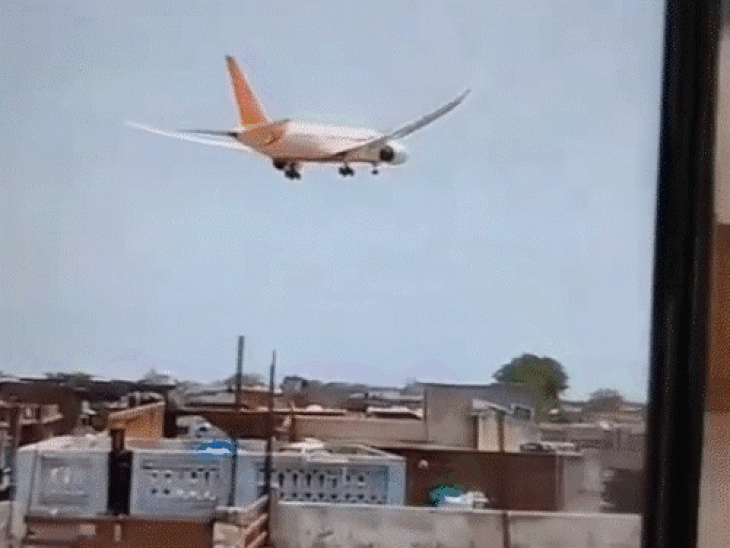New Delhi1 minute ago
- Copy link

In the BJ Medical College’s hostel building, more than 60 doctors, students and some other people were present at the time of the accident. Of these, 34 have died. Due to this, the death toll reached 275.
The day of 12 June 2025. Air India flight AI-171 took off from Ahmedabad Airport to London at 1.38 pm 40 seconds. The plane reaches a height of 625 feet and achieves top speed of 174 knots, then starts coming down rapidly. Pilot Sumit Sabharwal and K-Pilot Clive Kundar call air traffic control i.e. “Made” to ATC.
Sumit Sabharwal says- Mede, Mede, Mede … Thrst are not getting, the plane is not getting up. can not live. Sumit had a flying experience of over 8,200 hours. The pilot also had a 1,100 -hour flying experience. Then what happened that this flight of Air India became a big fire ball in a few seconds. This happened due to some mistake of the pilot or by a technical problem in the plane of Boeing.
241 out of 242 passengers and crew members died in this accident. Only one Indian -origin British traveler was saved. This was the first crash in the history of Boeing 787-8. The investigation of the accident has started and in the initial estimates, there are 4 types of theory of experts by taking this crash …
1. Both engines malfunction
2. Fuel contemporary ie contaminated fuel
3. Takeoff without flaps
4. Pilot accidentally picked up flaps

The entire aircraft was destroyed in the accident. Different parts of the aircraft are scattered at the scene.
These four theories have alternately analysis with the experts. But to understand this easily, the science of flying plane also has to be understood. So first of all, the main parts of the airplane and their work are known…
- The ship is at the forefront. There is a cockpit behind it, where the pilot sits and controls the ship with steering, pedals and instruments.
- Wings i.e. wings that give lift. They also contain fuel tanks. There are turbofan engines under the wings, which speed the ship.
- The middle part is called fuslas. It is the part of the airplane, which adds all the rests such as wings, tails, engines. It has passengers and their belongings.
- Heavy items are kept in cargo hold below. At the back is the tail, which is used to bend the ship up-to-down and right-left.

Now understand takeoff, cruise and landing…
Takeoff:
Plane wings consist of airfoils, which are slightly flat from the top and a slightly flat from the bottom. Due to this shape, when the ship runs fast on the runway, the wind passes over and down the wings. The air above the wings rises rapidly, which accumulate less air molecules and also makes the pressure less.
The air under the wings is slow, so there are more air molecules accumulated and the pressure is also made more. These pressure differences and more air molecules pushed down the ship.

The air above the wings rises rapidly, and the pressure is also reduced. The air under the wings is slow, and the pressure is made more. It pushes the difference of pressure and the ship.
It can also be understood by Newton’s rule. Newton’s third rule states: “Every action has an equal and opposite reaction.” That is, if an object forces the other object, then the second object also puts the same force on the first, but in the opposite direction. Plane’s wings press the air molecules down and these molecules put force in the opposite direction, which leads to the plane up. In easy language, the wings of the ship press the air down, which leads to the ship up and can fly.

Plane wings consist of airfoils, which are slightly flat from the top and a slightly flat from the bottom. The entire wing of the aircraft is formed by these Air Force.
It is important to understand one more thing here that the higher the speed of the ship, the more air molecules will be deposited and the ship will get the same lift. During the takeoff, the pilot gives a full throttle to the turbofan engine, making the ship run fast on the runway.
Apart from this, there is also a big role in the angle of the angle of attack in raising the ship. The lift increases due to excess of angle of attack. It is extended from the elevator installed in the tail at the time of take off. By raising the elevator, the tail of the plane goes down and the nose up.

Airplane flaps and slats i.e., the back and forward moving plates of the wings also help to generate lifts. Where the runways are small, the plane gets more lift with their help.

Cruise:
The airplane has to walk fast to stay in the air, so that the wings continue to get lifts. If the speed is reduced, the ship will fall down due to weight.
Tail is useful to turn in the air. The elevator is for up-to-down movement. The right-left turn is a ruder, which bends the ship with air pressure. The pilot controls all this with the cockpit.
Landing:
The pilot reduces the speed of the engine, lowering the lift and the ship slowly comes down. Control is also maintained in low speed by opening flaps and slats. Spollers (small plates) open on wings, which reduce lifts and increase air resistance. The air is thrown forward by applying reverse thrust in the engine, which slows the ship. Tires also have brakes and the ship stops on the runway.
The 4 theory of AI’s Boeing 787-8 aircraft Crash of AI is understood by Aviation Expert and Commercial Pilot Captain Steve. Captain Steve has blown both Boeing 777 and Boeing 787…
1. Both engine malfunctions: Some people believe that the two engines of the aircraft stopped working together, which ended the lift of the aircraft. But according to Captain Steve, this theory is weak.
In the video, there is no fire, smoke or spark from engines, which usually appears when the engine fails. Even if a flock of birds had penetrated into the engines, there would have been some marks, but there is nothing like that.
Captain Steve also said that Boeing 787 could also fly on an engine, and even if an engine had failed, the aircraft would not have crashed so quickly. The possibility of both engines fail simultaneously is quite low.

There is no fire, smoke or spark from engines, which usually appears when the engine fails.
2. Contaminated fuel: If fuel contemporary was there, before takeoff, when the pilots increased the power of the engines, there would be indications of malfunction in engines. For example, the engine “sputtering” ie, behaving intermittently or behaved unusual. But according to video footage and preliminary information, the aircraft ran on the runway at a normal speed, raised nose at normal rotation speed, and started the takeoff. This suggests that there was no clear malfunction in the engines in the initial stage of takeoff.
3. Takeoff without flaps: The third theory is that the aircraft took off without flaps. But this is also almost impossible. Boeing 787 has an electronic checklist, which ensures that flaps are in the correct position. If the flaps had not been installed, the red lights in the cockpit, the loud horn ringing, and the pilots would have known immediately. It is impossible to ignore so many warnings.
4. Flaps were accidentally picked up: Captain Steve’s most potential theory is that after takeoff, the co-pilot accidentally picked up the flaps instead of lifting the wheel. Steve says that after the takeoff, the pilot may have asked his co-pilot to lift the landing gear, but the co-pilot accidentally picked up the flaps, causing the aircraft’s lift to suddenly reduce.
The video shows that the landing gear remains down even after the takeoff, which is not normal. The gear is lifted 50 feet after the takeoff, but in this case it did not happen even after the aircraft went to a height of 600 feet.
In this case, it may happen that the sudden rise of flaps in place of landing gear reduced the speed of the aircraft, losing the balance. The pilot tried to create a lift by pulling the nose up, but by then it was too late. The pilot did not have recovery time. All this happened in just seconds.

In this picture, the landing gear of the aircraft is seen below. It is falling downwards even after the aircraft is up.
What will happen next?
Captain Steve said- This theory is just an estimate. In the coming days, the truth can be revealed by the investigation of the black box (flight data recorder and cockpit voice recorder).
In the investigation of the plane accident, 8 agencies are doing. In this, National Investigation Agency, Gujarat Police, Aircraft Accident Investigation Bureau (AAIB) Directorate General of Civil Aviation (DGCA), United Kingdom’s Air Accidents Investigation Branch (UK-AAIB) United States of United States (FAA).





